History
Dominic Guzman from Spain, founder (in 1216) of the Order of Preaching Friars
(aka The Dominicans) died
here (having come to preside over the second General Chapter meeting of
his order) on the 6th of August 1221, two years after establishing the monastery on this site
and building a small church, a convent having been established for Dominic
at the Mascarella church by the Blessed Reginald of Orleans in 1218.
Dominic
was buried here, in the church then called San Nicolò delle Vigne.
Following the death of Saint Dominic, between 1228 and 1240, the church
was expanded and a new complex built. The apse of the old church was demolished
and the nave extended as the church became the late-Romanesque Basilica of
Saint Dominic, dedicated to the saint by Pope Innocent IV in 1251. It had
two distinct interior spaces: the east end, with its choir stalls and high
altar, for the friars, with its vaulted ceiling suited to singing; and the
west end for the laity, with a flat wooden roof whose acoustics were
suitable for preaching.
The saint's burial place in the choir soon became famous for miracle cures and Ex voto
offerings began to accumulate - wax images of the eyes, hands, feet, and
other parts that had been cured of afflictions. The friars found all this
inappropriate to the humility of their order and removed and destroyed the
offerings and forbade these
offerings and drapings with silk textiles. This state of affairs lasted for 12 years,
before a chapter meeting of 1233 decided to move the saint's body to the
right aisle of the church and placed in a plain marble sarcophagus. During
translation it was found to be perfectly preserved, of course, with an
'odour of sanctity' about it. His canonisation naturally followed upon
this discovery, in 1234, thirteen years after his death. The saint's new
resting place was in a less holy but more accessible position, west of the
tramezzo screen, where he
remains, to encourage lay devotion and, it was hoped, a cult to rival that
of Saint Francis. This was only slowly achieved, Dominic being a more
retiring founder, having not written a Rule for his order, and only slowly
appearing in works of writing and art. The original modest sarcophagus was
replaced by the famous shrine detailed below in 1267, with many additions
over the centuries. When the saint's bones were removed to safety in 1943
it was found that only 125 of the 208 bones in the human body were
present, so it was assumed that the rest had been distributed as relics to
other churches.
The dividing screen (or tramezzo) between the area for the brothers and the area for the
laity, and containing the pulpit for preaching to the laity, was demolished in the early 17th century, when the the choir was
also moved behind the altar. Between 1728 and 1732 the interior of the
church was rebuilt in Baroque style by Carlo Francesco Dotti.
The façade
Restored in 1910, during which work the rose window was
reinstated, after the postcard photograph (see
far below right) was taken, which still shows traces of the lost
portico, built by Dotti during his rebuilding from 1727-35, and visible in
various images at the bottom of this page. It was demolished by Alfonso
Rubbiani in 1874.
To the left of the façade is the Latin cross shaped Ghisilardi chapel, designed by
Sienese architect Baldassarre Peruzzi c.1530, but it's rarely open.
Interior
Long, narrow, baroque and white, with chandeliers, and dating from its
remodelling by Carlo Francesco Dotti from 1728–31. A nave and two aisles, with 17th/18th-century art in the chapels
and in the ten high lunettes facing into the nave. Moving from
the back there are five bays, three low and two high then
a transept effect, with the chapel of Saint Dominic as the right arm. Then four
more bays, two shallow and two deep, with the first left-hand deep bay leading to the
enclosed, tall and large. Then there's the real transept and a long sanctuary with a choir.
The mid-14th-century marble tomb of Taddeo Pepoli, a
law professor from a wealthy banking family, has reliefs commemorating his
endowing and decorating six side chapels here, on which he presents each
chapel to its dedicatory saint..
Left side
Starting on the left, in the north aisle, over the
second altar is Saint Raymond of Penafort, riding the waves
from Majorca to Barcelona using
his habit as a sail, originally by Ludovico Carracci, but the original was
lost and this is a copy from 1734. The very decorated
Chapel
of the Rosary
(opposite that of Saint Dominic) overpowers an altarpiece incorporating
fifteen
small and dark paintings of the Mysteries of the Rosary from
the mid-1590s by Ludovico
Carracci, Lavinia Fontana, Bartolomeo Cesi, Denys Calvaert, Alessandro
Tiarini, Guido Reni (who is buried in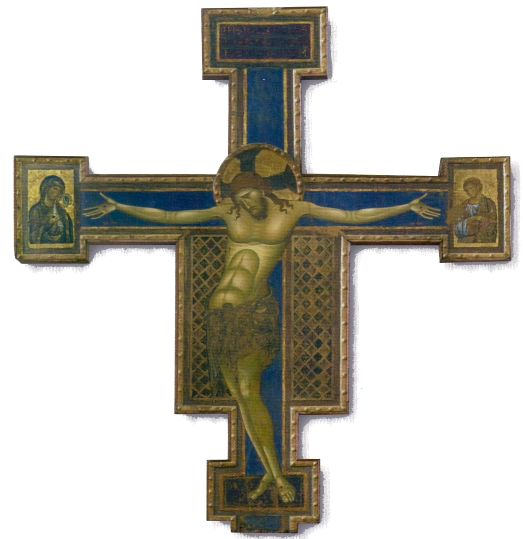 this chapel) and Francesco Albani.
Legend has it that the Virgin gave a rosary to Saint Dominic as
protection against the Albigensian heresy, and for much of the Middle Ages
Confraternities of the Rosary were under Dominican control. In this chapel
is also the organ that Mozart practiced on whilst in Bologna to take the
entrance exam for the Bologna Philharmonic Orchestra.
this chapel) and Francesco Albani.
Legend has it that the Virgin gave a rosary to Saint Dominic as
protection against the Albigensian heresy, and for much of the Middle Ages
Confraternities of the Rosary were under Dominican control. In this chapel
is also the organ that Mozart practiced on whilst in Bologna to take the
entrance exam for the Bologna Philharmonic Orchestra.
In the north transept, an inscription of 1731 marks the tomb of King Enzo.
The adjoining (fenced off) chapel has a c.1250 painted Crucifix signed by Giunta
Pisano (see right). The Dominicans thereby followed the lead of the Franciscans in
Assisi in their commissioning of Giunta to paint a Crucifix with
the more Byzantine-influenced iconography of a dead (or dying) Christ,
rather than the then more usual triumphant representation.
East end
To the left of the sanctuary is the chapel of SS Sacramento, to the right is
the small Casali Chapel containing a lovely
Mystic Marriage of St
Catherine with Saints John the Baptist, Peter, Paul, and Sebastian of 1501
by Filippino Lippi, a late work. The Casali coat of arms can be seen on
the pietra serena overdoor in the painting.
Through here you can access (after making a €1
donation) a sequence of special spaces.
Firstly the bright choir with its
famous intarsia
stalls and lectern (1528–51) by Fra Damiano da Bergamo, with help from his
brother Stefano. Panels depicting episodes
from the New Testament are on the left, with the Old Testament on the
right right, with 7 further episodes in a recess in the centre of the back
wall. The lectern has illusionistic panels. The huge altarpiece here in a
big gilded frame is an Adoration of the Magi by Bartolomeo Cesi, flanked by panels
depicting Saint Nicholas of Bari and Saint Dominic, also by Cesi. Below is
a predella with a Last Supper by Vincenzo Spisanelli.
The usually-closed
two-room museum is next. Aside from the usual cases of reliquaries, copes,
chalices and monstrances it contains a fine bust of Saint
Dominic by Niccolò dell’Arca - a polychrome terracotta half-length
figure of the saint reading. Also the 14th century Madonna of the Velvet
by Lippo di Dalmasio, frescoes by Ludovico
Carracci (depicting The Charity and Saint Francis) and Bernardino Luini, and intarsia panels by Fra Damiano
of the Life of Saint Jerome. Also Saint Louis's finger in a gold
reliquary given by Philip IV after (his father) the saint's canonisation
Beyond
the sacristy, through a door off the right transept, where there is a painting by Guercino of Saint Thomas Aquinas
bothered by angels
from 1662, before you return to the main church, is the 14th/15th century Cloister of the Dead, its fourth side
protruded into by the Chapel of St Dominic (see photo
right). This cloister is where
foreigners who died in Bologna were buried. An easily-missed slab opposite the
aforementioned apse marks the burial place of
persons from Britain.
Right side
Chapel of Saint
Dominic (see right)
Back in the church the highlight
Chapel of Saint
Dominic, off of the south aisle, was originally Gothic (built
1413) but was rebuilt in 1597–1605
by Floriano Ambrosini and
restored in the 19th century. It has Saint Dominic in Glory by
Guido Reni (an artist much-employed by the Dominicans) in the apse semi-dome, and provides a very decorated setting for
the famous tomb (Arca) commissioned in 1264, where the
saint is buried. The sarcophagus (see below) has high relief scenes from the saint’s life, carved
in 1265-7 to designs by Nicola Pisano, with the help of Fra’ Guglielmo
Agnelli (a Pisan Dominican friar), Pagno di Lapo and the much more famous
Florentine Arnolfo di Cambio. On the front two
episodes flank a statuette of the Virgin a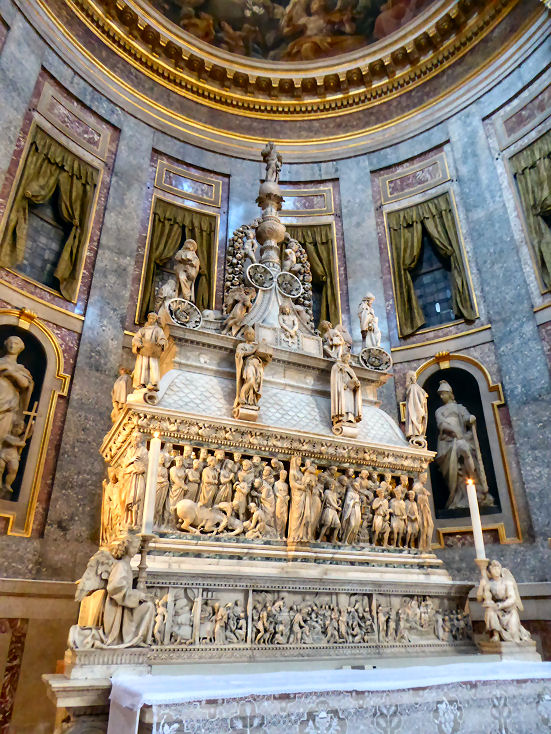 nd Child, one
shows the miraculous resurrection by the Virgin of a young man who had fallen from his horse, and the other
the saint with a holy text written by him which has
survived the flames of the fire below (where pagan texts are burning). The
latter episode happened after some judges were unable to solve a dispute between Dominic and an erudite pagan
and so ordered that both texts be burnt. (or
Saint Dominic throws a book of orthodox learning into a fire to show some Cathars, when it doesn't burn, the error of their ways.) These episodes
show how Dominic is more often portrayed as an intercessor, in contrast to
Saint Francis's more active role as alter Christus. nd Child, one
shows the miraculous resurrection by the Virgin of a young man who had fallen from his horse, and the other
the saint with a holy text written by him which has
survived the flames of the fire below (where pagan texts are burning). The
latter episode happened after some judges were unable to solve a dispute between Dominic and an erudite pagan
and so ordered that both texts be burnt. (or
Saint Dominic throws a book of orthodox learning into a fire to show some Cathars, when it doesn't burn, the error of their ways.) These episodes
show how Dominic is more often portrayed as an intercessor, in contrast to
Saint Francis's more active role as alter Christus.
The lid of the sarcophagus
and its crowning sculpture, added two hundred years later, was designed by Niccolò dell’Arca, who took his
name from this very tomb (arca). It has eight statuettes of the
protectors of Bologna. Three years after Niccolò’s death in 1492, the
young Michelangelo, who was staying for a year with Gianfrancesco
Aldovrandi, carved two of these statuettes - Saint Petronius holding a model of
Bologna (with his right leg extended) and (behind) Saint Proculus, with a cloak over his left shoulder (next to
Saint John the
Baptist, which was the last sculpture to be made for the monument in
1539). Michelangelo also carved the right-hand angel, kneeling and holding
a candlestick, as a pair to the left-hand angel by Niccolò dell’Arca, which is much sweeter than Michelangelo's beefier version. Niccolò
was still alive when Michelangelo carved his figures, but it's not known
why the work passed to Michelangelo, or what Niccolò thought of this
development.
The small reliefs between the two angels are by Alfonso Lombardi (1532). They
illustrate (on either side of a central Adoration of the Magi) the
birth
of Saint Dominic, the penitent Dominic asleep on the hard floor, his selling his books to help the poor, and
his climbing to heaven on a ladder held up by the Redeemer and the Virgin.
The altar beneath is 18th century. A illuminated niche around the back contains a
sparkly reliquary of 1383 by Jacopo Roseto da Bologna, made to house the saint’s skull. The
sarcophagus is crowned by a figure of The Redeemer Holding the World,
standing on a terrestrial globe. Below are festoons of fruit, representing
the Earth,
held up by putti, and eight dolphins representing the sea. Two
angels kneel on either side of Christ in Pietà and at the
four corners there are figures of the Evangelists, in exotic head-dresses.
Campanile
Gothic in style, from 1313, and recently restored.
Also buried here
The funeral of painter Elisabetta Sirani was held here in 1665. She was a
celebrated and successful artist, and teacher of many female artists, who
died after two days in great pain at the age of 27. Rumours then started
to circulate that she had been poisoned, but she most likely died of
peritonitis after a ruptured peptic ulcer. She is buried, along with Guido Reni, her father's teacher, in the Rosary Chapel here.
Conversion Controversy
In the
mid-19th-century a famous case of Edgardo Mortara, a Jewish child baptised
a Christian by his nurse, and then taken away from his parents when she
revealed her actions became a cause célèbre. At the instigation of
the Inquisition the nurse, Anna Morisi, was interrogated by the Dominican
friar Pier Gaetano Feletti at this church. An unsurprising choice of venue
given the Dominicans reputation for toughness on heresy. The affair became
an international scandal, murkily mixed up in the fall of the papal states
and the Unification of Italy, with Feletti later standing trial for his
actions.
Lost art
in the Pinacoteca
A large polyptych by Simone dei Crocefissi of c.1365/70, showing the
Coronation of the Virgin in the centre with 18 Saints, a
Crucifixion and a Resurrection.
A Last Supper panel by Andrea di Bartolo (c.1420) (see right) from the room of
the inquisition here.
An Adoration by Giovanni Francesco da Rimini.
A Mystic Marriage of Saint Catherine with Saints (featuring an
adult Christ) from the choir here, by il Bagnacavallo.
The Massacre of the
Innocents by Guido Reni, (1611) was commissioned for the Berò (later
Ghisilieri) chapel
here. It was looted by Napoleon for the Louvre in 1796, was returned in
1815 and since 1817 has been in the Pinacoteca.
Lost art
elsewhere
An altarpiece depicting The Virgin Appearing to Saint
Hyacinth by Ludovico Carracci, formerly to be found in the St Rose of
Lima chapel (first on the right), is now in the Louvre. Saint
Hyacinth was a then-only-recently-canonised (male) 13th-century Polish
Dominican.
An altarpiece by Girolamo da Treviso of the
Virgin and Child with Saints Joseph, Philip and James, and Filippo
Fasanini at Prayer is in the National Gallery in London. It was
painted c.1532-3 and used to be in the chapel of Saint Philip and Saint
James which adjoined Saint Dominic's shrine here. The painting was removed
during Dotti's rebuilding of the interior between 1728 and 1732.
Lost art (mostly from tombs)
in the Medieval Museum
A fine 13th century French stained glass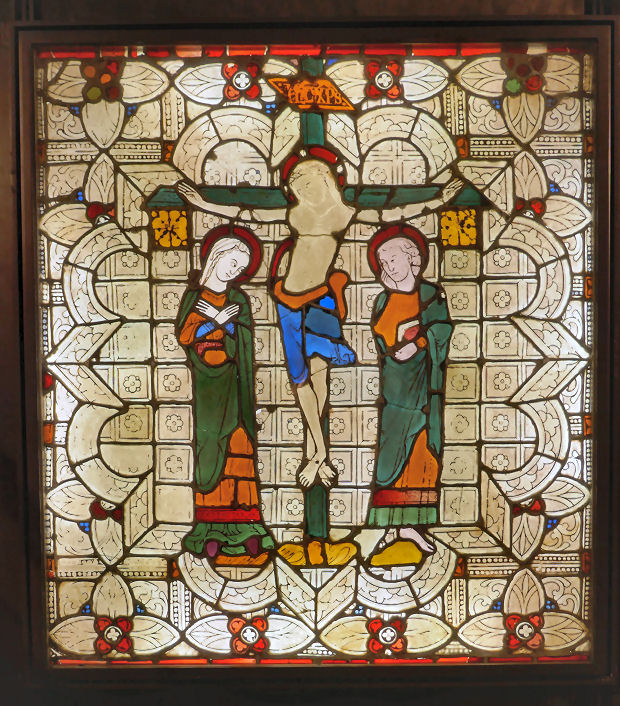 panel depicting The Crucifixion (see right)
is now in the Medieval Museum.
panel depicting The Crucifixion (see right)
is now in the Medieval Museum.
As is an opus
anglicanum
embroidered cloak from the early 14th century with scenes from the life of
the Virgin and Christ, and a panel showing the martyrdom of Thomas Becket.
The latter reflects the patron's recognition of the authority of the pope
as Becket had been murdered for refusing to admit the superior authority
of the king.
The spectacular tomb of law professor Bartolomeo da Saliceto by Andrea da
Fiesole from 1412, and parts of the 1383 tomb of jurist Giovanni da
Legnano by Venetians Jacobello and Pierpaolo dalle Masagne, once in the
right transept here. From the left transept the tomb of Giovanni d'Andrea,
another jurist, who died in the plague of 1348, is also in the Medieval
Museum's room of tombs. The tombstone of the Bolognese knight Filippo of
the Desideri, from the first half of the 14th century, by Arriguzzo
Trevisano. From the cloister here both the 1330 tomb of Matteo Gandoni,
made by the Ventura studio and the early 14th century tomb of Bonifacio
Galluzzi, the latter by Bettino da Bologna. The early 15th century
limestone tomb slab of master Pietro D'Ancarano.
An early 16th century illuminated psalter, on
display in the Medieval Museum, the work of Giovanni Battista Cavallotto.
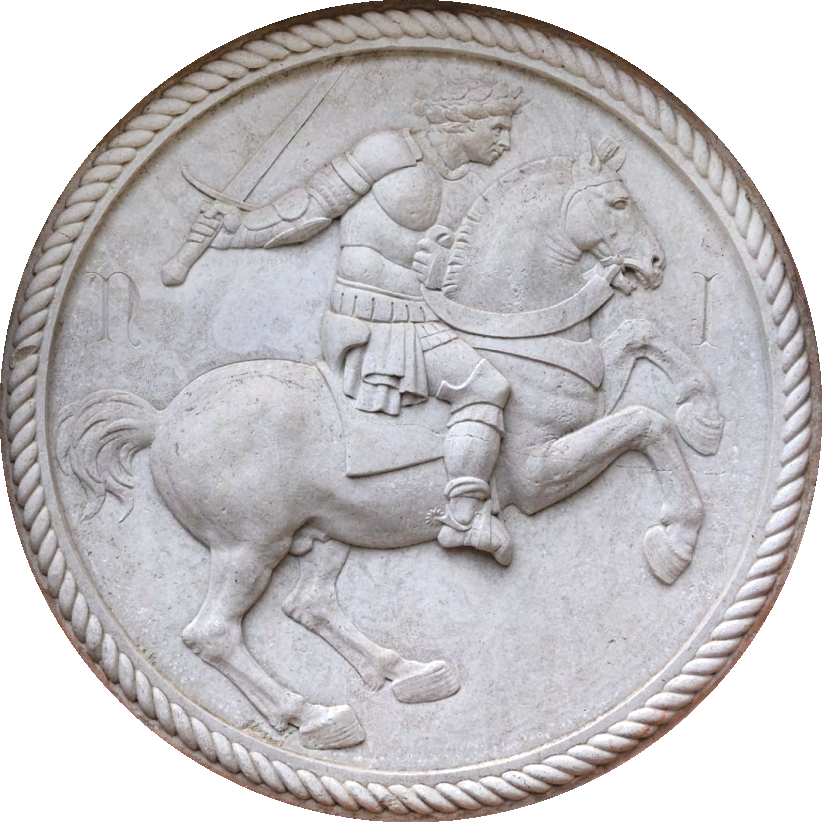
Lost tomb stonework elsewhere
A group of Three
Acolytes
from the sarcophagus of Saint Dominic here by Arnolfo di Cambio(?)(c.1267)
is in the Bargello in Florence.
Brackets from the tomb of Giovanni da Legnano, mentioned in the section
above, were re-employed as balcony supports in the 19th century castle of
Rocchetta Mattei, just outside Bologna. Built by Count Cesare Mattei, the
inventor of electrohomeopathy, this castle also has, inset above an
external door, the Ludovisi tondo, depicting a man in armour on a horse
brandishing a sword (see right).
This sculpted tondo has recently (Burlington Magazine January 2021) been
ascribed to Jacopo della Quercia and said to be from the memorial to
Niccolò di Lego Ludovisi, erected by his son Giovanni in the family vault
in the cloister here.
The church in art
Friars in the San
Domenico Choir in Bologna 1892 by Giovanni Masotti
(see
above right).
Piazza San Domenico in Bologna
c.1880 by F. Mironi (see below).
Opening times
Monday to Friday 9.00 - 12.00 and 3.30 - 6.00
Saturday 9.00 - 12.00 and 3.30 - 5.00 Sunday 3.30 - 5.00
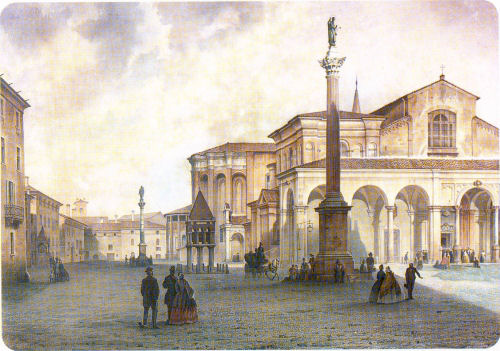
|
|
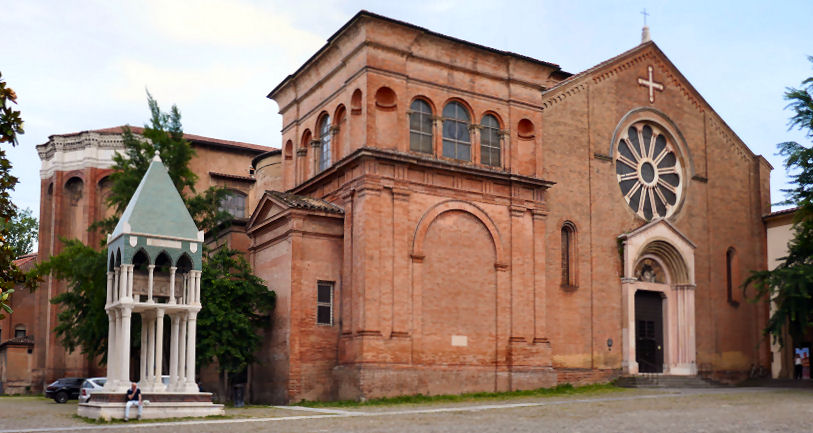
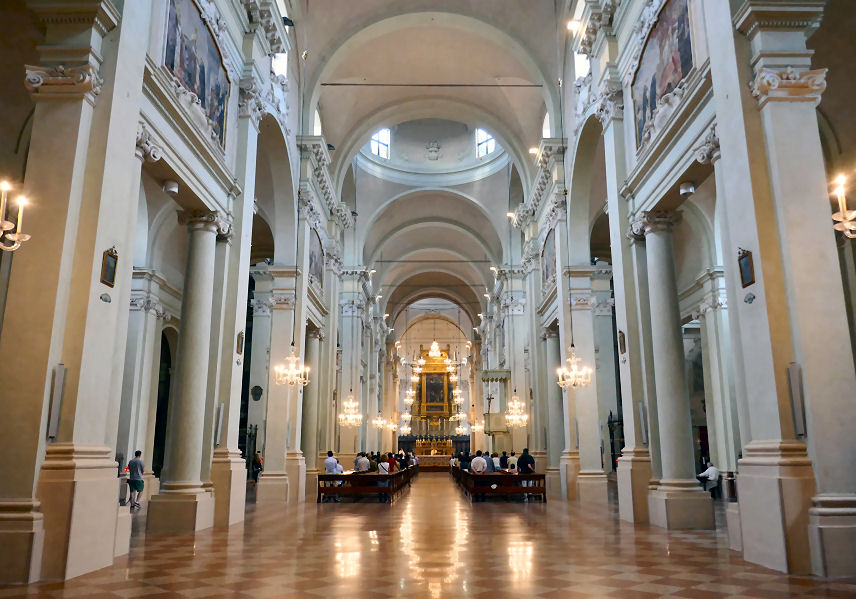
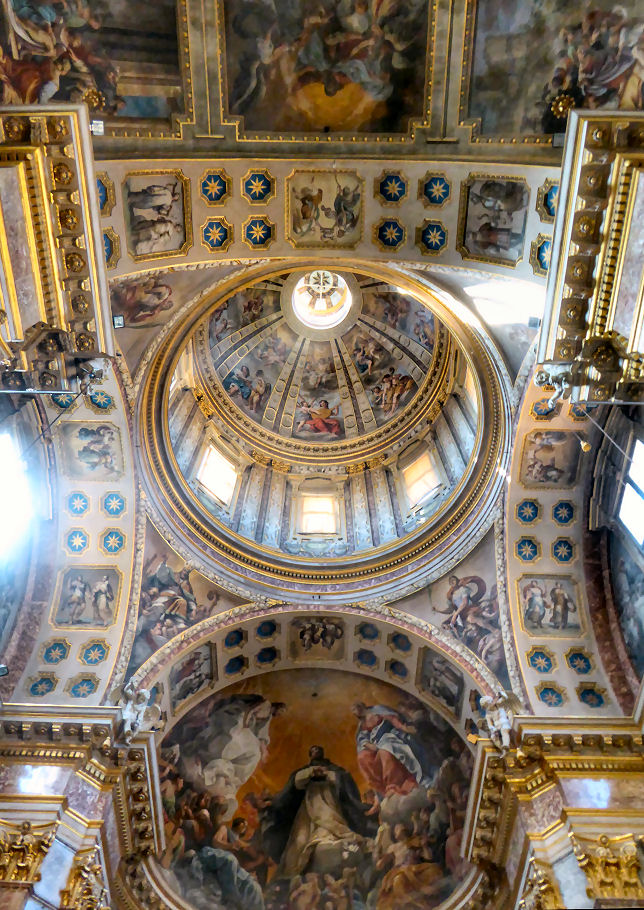
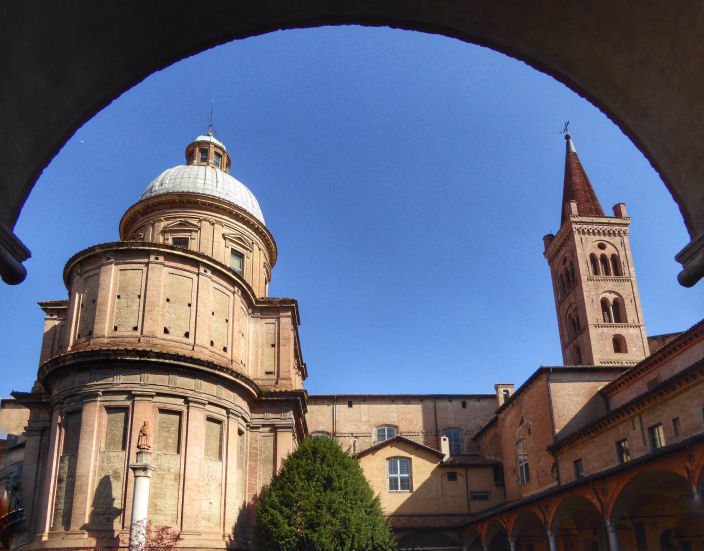

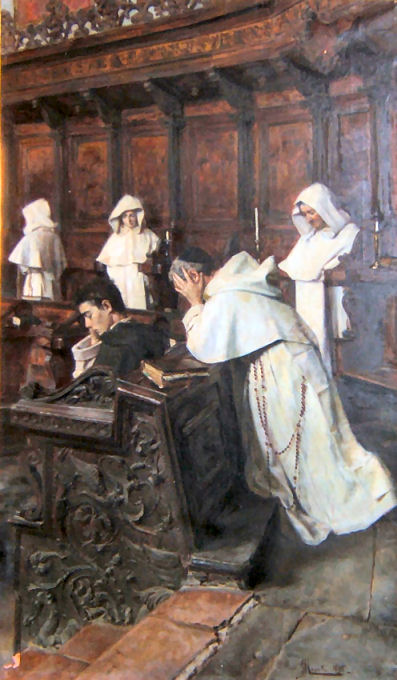 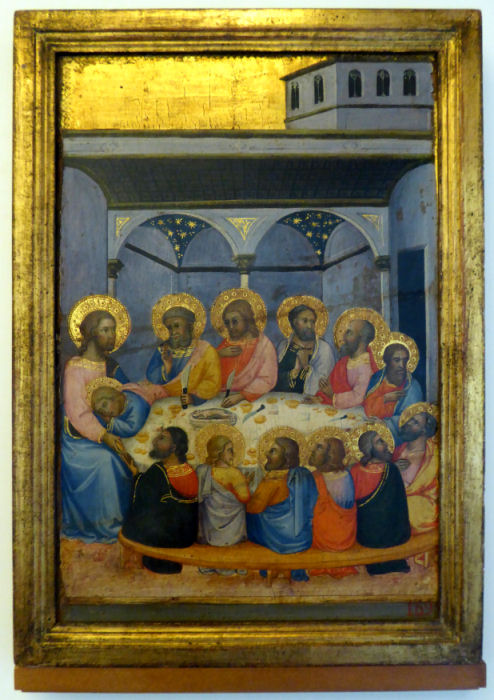

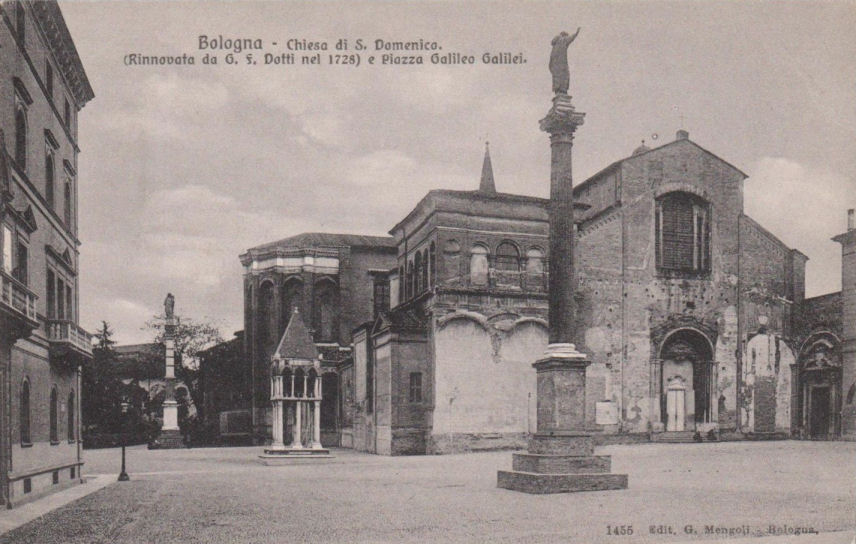
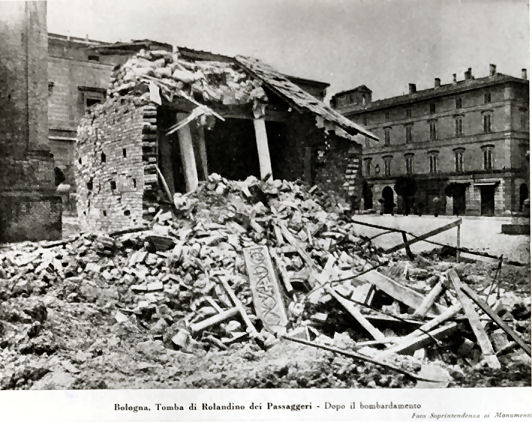
The 1310 tomb of Rolandino de' Pasageri following an
allied bombing raid in 1943,
despite being protected by a brick hut.
|